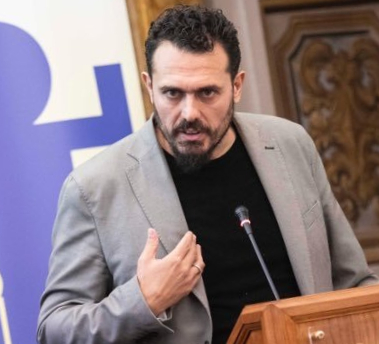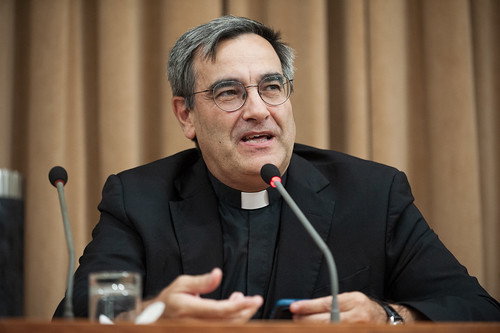Organizer of Event with Pope on Encouraging Families
Exclusive Interview with President of Forum of Family Associations, Host of General States of Birth Event

In addition to Pope Francis, Italian Prime Minister Mario Draghi will also address the General States of the Birth Rate, planned for May 14 at the Auditorium of Via Della Conciliazione, beginning at 9:30 am. It is an online event organized by the Forum of Family Associations. Exaudi had an exclusive interview with the Forum’s President, Gigi De Palo, committed for years in a genuine battle against the demographic winter and for a fairer tax for families.
What are the General States of the Birth Rate?
For five years I have been insisting that the Forum pursue the subject of birth to address the vaster one of family policies. It’s necessary to understand that if the family doesn’t restart and, hence, births, consumption won’t restart and everything could collapse. This is the way to get more attention. Therefore, the General States are the way in which we try to speak not only to the world of politics but to address the country’s system, extending the field to involve the world of the media, of banks, of businesses, of entertainment, and of sports.
And What Is the Objective?
The General States are useful to reflect on a series of realities and personalities to whom perhaps, it doesn’t come spontaneously to reflect on these subjects, who do not realize that their sectors are also at risk if the demographic winter isn’t stopped. Minister of Education Bianchi has just launched an alarm on the fall in the number of students with the risk of the closure of schools. It’s an example. Our country is in a phase of great change, which won’t be sustainable if we continue in this way. Therefore, we want to seat individuals around a table to reason on this. Also for those who say that nothing changes, I am thinking of the banking and real estate systems. It’s not so.
How Will the Meeting Unfold?
There will be the intervention of the Council’s President, Mario Draghi; the Holy Father’s greeting and institutional greetings of Ministers and Authorities, then three tables. The first will be “Enterprising Birth Rate!” with the Managing Directors of ENEL, Post, Open Fiber, and the President of RAI, moderated by Cazzullo, the journalist of Corriere, on the relationship between businesses and children. The second table will be on the subject “New Births, a Good Investment.” Taking part in the debate will be Gatti, the General Manager of Dedercase; Sara Doris, President of the Mediolanum Onlus Foundation, mother of five children; Sesana, CEO of the Generals and Chiara Bidoli of RCS. Finally, the last table, “Children, a Beauty to Tell,” will involve the world of the media, of sport and of entertainment with the soccer player of Lazio Real Estate and his wife Jessica, actress Anna Foglietta; Luca and Paola Bernabei of Lux Vide; journalist Marco Tarquinio, Director of “Avvenire”, and Annalisa Cuzzocrea of “La Repubblica”.
Were You Hoping for the Pope’s Presence?
I asked him in a very simple way during a meeting. He was impressed and made me understand that he was interested. We are very happy that, in the midst of his numerous commitments, he found a way to be present.
And what do you expect from the Holy Father?
In Italy we are aware of the demographic situation, we know the numbers, it’s all clear to us but we are like a boxer who stays on the spot. We asked the Pope to give us a higher and different key of reading, to steer us from the point of view of hope. The falling birth rate is not only an economic but also a cultural question; the two aspects go hand in hand. The Pope can help us to talk about the reason we no longer have hope: a child is born of the desire of life, of a future.
So the demographic winter is not only an economic question?
No, but the economic aspect is what, in a certain sense, conditions the culture. If it wasn’t so difficult to have a child, if it wasn’t the second cause of poverty, then it would only be a cultural problem. In this connection, Professor Rosina of the Catholic University has done several surveys over the years. If young people between 18 and 29 are asked what they want, 94% answer a family and children. And when asked about the number of children, 80% answer two or more. If a woman is asked this question, she answers that she wouldn’t like two. But in Italy <only> 1.29 are had.
This shows that the economic aspect conditions the cultural aspect. It’s clear that in the long run, it becomes a mentality. In a country in which there are ever fewer children, services for children decrease and also culturally you become less likely to imagine yourself, to think of yourself as a father or mother. The graphs show that in as much as we were in a phase of decrease, the drop in Italy’s births happened after the 2008 crisis.
On the economic plane, will the single child allowance, which should start in July, bring us closer to Europe?
We are so late that too many things are necessary to bring us closer . . . Let’s say it “moves the ranking” to use sports jargon. It tries to put an end to tax discrimination, so long as it is done well. The Forum has worked to compact the political world. The result was that the Parliament (except for 4 that abstained in the Senate) voted this measure unanimously. We convinced public opinion of the goodness of this reform but it must be done well. In other words, you cannot allocate less money than you need. It would be crazy. 10-11 billion would be necessary compared to the 6-7 foreseen. Things are either done well or they become a problem.
Why?
The safeguard clause is not enough, because the reform is not geared to a draw but to improve the life of Italian families. Otherwise, it’s a mockery. Draghi showed much interest, he has spoken about it often; we hope that the reform will be implemented well. Then there is a second part, to be done, we hope, next year, which is the fiscal reform that takes into account family responsibilities. The third issue is to implement measures in the recovery and resilience plan, which will help to restart the birth rate. Nursery schools are doing very well but if there are no children what will we do with them?
Can the recovery plan be an occasion?
The macro-voices were illustrated; now it’s necessary to enter in the specific. My hope is that, in addition to generating work and innovation, measures will be taken to restart the birth rate. It’s good to invest in health care but if we continue on this way the expense will be unsustainable because there will be more elderly than young people and who will pay the taxes to keep it free? It’s not so much a question of having children just to have them, but to give young people the conditions to realize their dreams. And on top of that is the issue of forming a family. Perhaps the demographic trend won’t change but it will be necessary in 20 years to come to a different gap between young and elderly people from that which the estimates are highlighting. Otherwise, the system will be unsustainable. Suffice it to think of the issue of pensions or care of the elderly.
Your commitment began with the campaign “I’m with strollers,” launched seven years ago. What has changed since then?
From the point of view of the birth rate, nothing has changed. The situation has only worsened. Nothing has been done. The great cause is that governments in Italy last little and, unfortunately, these reform policies call for time. I think the true victory was to have made everyone vote for the same measure: now the law exists. In any case, if the government falls tomorrow everyone voted for the law and we can start from there. It can be changed, improved but this action unites all.
 (EN)
(EN)
 (ES)
(ES)
 (IT)
(IT)





